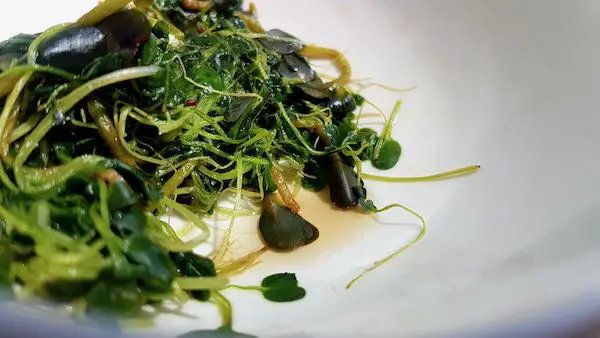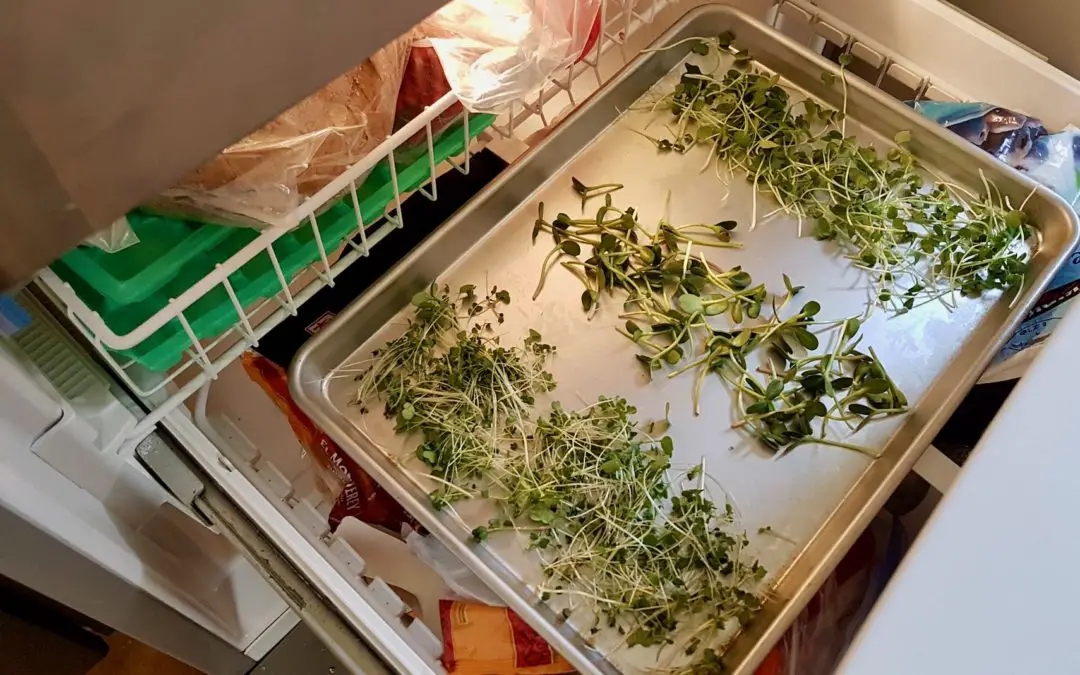You can freeze just about any food, but is it a good idea to freeze microgreens? I wanted to find out first-hand what would happen, so I did my own testing and put three types in the freezer (pictured above!)
You can freeze microgreens, but it will change the flavor, texture, color, and nutrient contents of the microgreens. Freezing ruptures cell walls in microgreens, catalyzing chemical reactions that reduce certain nutrients and boost others.
I wouldn’t recommend freezing most microgreens instead store them in the fridge properly (links to article about top tips for extending microgreen freshness) and just eating them faster. If you really have more microgreens than you can eat: try blending them into smoothie, or dehydrating.
Freezing is pretty smooth-sailing, but once you thaw them out, that’s when things really go downhill (for most but not all microgreens). Keep reading to find out which microgreens I do recommend freezing (and the almost unbelievable list of science-backed benefits).
Which Microgreens are the Best to Freeze?
Most microgreens I would advise you to just eat them fresh! Eat more if you have too many! Store them properly in the fridge and they’ll keep for over a week, up to two weeks if you’re careful.
But there is one type of microgreens that can actually benefit from freezing: Broccoli microgreens! Freezing broccoli microgreens and sprouts damages the cell walls in the plant and creates elevated levels of the isothiocyanate sulforaphane.
But when you thaw them, these compounds start reacting with the proteins in the slimy microgreen soup (microgreens get soupy when you thaw them). So you want to eat the frozen sprouts or microgreens before they thaw if you can.

This is my photo of what the microgreens look like after freezing. They are kind of slimy and unpleasant once you thaw them.
What is sulforaphane anyways?
Sulforaphane is the compound [SFN: 1-isothiocyanato-4-(methylsulfinyl)butane], and it’s found in cruciferous vegetables (like cabbage and kale), but also in broccoli, and at the highest levels in broccoli sprouts and microgreens.
As of 2019, sulforaphane was being trialed in 61 different clinical trials. If that’s not a good hint that the compound could have health benefits, I’m not sure what is. The benefits of sulforaphane are backed up by more and more data and hard science every year.
Sulforaphane is widely studied, and has been shown to have a number of benefits:
- Antioxidant (source)
- Antimicrobial (source)
- Anticancer (source)
- Anti-inflamatory (source)
- Anti-aging (source)
- Neuroprotective (source)
- Antidiabetic (source)
The health benefits in humans are numerous and wide ranging. It’s pretty fascinating stuff, and all you have to do is eat some broccoli sprouts or microgreens.
How to Freeze Microgreens
Wash them first! And make sure you harvest them properly, don’t pick up any dirt or seed hulls if you can avoid it as they can carry pathogens (links to article about microgreen food safety).
There are a few main ways to freeze microgreens:
- In the bag or container they came in
- Spread out on a tray
- In Ice cube trays with juice
The easiest (and worst!) option is to freeze the microgreens in the container they came packaged in. While it’s super easy to toss it into the fridge, all your microgreens will be frozen together into a tangled mess, so you’ll have to use them all at once, or try to chop them apart when you pull them out of the freezer.
A great option is to spread them out so they don’t freeze together, then collect them into a bag once they’re frozen. Spreading food out when you freeze it is also a great tip from a food safety perspective. Spreading food out causes it to cool down a lot quicker, keeping it out of the danger zone (40°F to 140°F)where bacteria and other pathogens multiply rapidly.
To freeze microgreens on a tray:
- Wash the microgreens under clean running water
- Let them air dry for a few minutes to remove the majority of the moisture
- Chop them into ½ inch sections (so they’re not stringy when you thaw them)
- Spread them out on a baking tray and
- Put them in the freezer for 1 – 2 hours
- Collect the microgreens and place them into a bag to prevent freezer burn
If you’re a smoothie person, you can also pack microgreens into ice cube trays, then top them up with juice! This way you have greens-packed cubes ready to go next time you make a smoothie. You don’t need to worry about cutting them up (the blender will do that), but it’s a good idea to wash them first
What Happens when you Freeze Microgreens?
When you freeze microgreens, the water in them crystallizes, this usually causes cell walls and other structures in the microgreens to be damaged. Then when you thaw them out the texture really changes.
When they’re fresh your teeth cut right through, crunch crunch crunch, but when they’re frozen it’s not the same story.
They also get stringy if you don’t cut them into little chunks. You can cut them into ½ inch chunks depending on what you’re planning to do with them.
You can imagine throwing a bunch of frozen microgreens into your next batch of soup, but when you go to eat it you have long stringy pieces, not great!
What Should I Cook with Frozen Microgreens?
Frozen microgreens are going to have a different texture than you expect from fresh ones. So there is a bit of thought that should go into what to do with them. Here are some great options:
- Smoothies (freeze microgreens into ice cube trays with juice)
- Soups, especially blended soups to minimize unpleasant stringy textures.
- Lasagna
- Chilli
For most cooked foods using frozen microgreens you’ll want to chop up the microgreens, it makes the texture a lot better.
How to Store Microgreens in the Fridge & Maximize Shelf Life
Store them in a sealed container, otherwise your fridge will draw humidity away from them and they will wilt FAST. Don’t put moist paper towels or anything like that over top. The natural humidity in your microgreens will be enough to keep them fresh.
Also, store them in the crisper drawer if your fridge has one, and close the vents! Crisper drawers are designed to keep humidity higher around your fruits and vegetables, so they stay crisp! Use it! They also moderate the temperature/cold air flow from the cooling coils in your fridge.
Some fridges get a little too cold right where the cold air enters the fridge and you can freeze leafy greens unintentionally!
If you found this information useful there are even more tips and tricks that can maximize how long your microgreens keep for here:
How to Store Microgreens After Harvest & Maximize Shelf Life (Links to Article)
Is It possible to Dehydrate Microgreens?
Dehydrating microgreens is definitely possible, and a great way to preserve microgreens so they can easily be added to smoothies or taken with you on-the-go.
For best retention of nutrients, you want to dehydrate microgreens at low temperature, and out of the sun.
Dehydrated microgreens can be used for all kinds of things:
- Snacking, put a little bit of your seasoning of choice and they’re ready
- Grind into greens powder, can store for a long time, add to smoothies when you’re ready
- Add dehydrated microgreens to soups for flavor and texture, but it’s best to crush them up first so you don’t get stringy bits
While laying microgreens out in the sun works great, it also bakes out a lot of the beneficial compounds, so avoid it if you have a choice.
Use a food dehydrator on low, or if you’re a business, you might consider dehydrating with a freeze-drying method (which can preserve a lot of the beneficial phyto-compounds).
Conclusion
While microgreens can be frozen, you should avoid it if you can. Just eat more greens! And take care to store your microgreens properly in the fridge to extend their shelf life.
Broccoli releases elevated levels of sulforaphane, an incredibly potent and healthy compound. Sulforaphane has been shown to provide powerful health benefits.
If you enjoyed reading about freezing microgreens, you might enjoy reading more about how to store them properly:
How to Store Microgreens After Harvest and Maximize Shelf Life (Links to article)
Or if you’re curious about some of the dangerous practices to avoid, and how to safely grow and eat raw microgreens, check out:
Can Microgreens Make you Sick? (Links to article)
Sources

I’m Alex Lafreniere. I learned a lot about plants when I built and operated a landscaping company. I learned even more when I started growing and selling Microgreens. But, learning is a journey, not a goal. Ever since travelling across the world, I’ve wanted to find ways to bring more delicious and exotic plants into my life. This is the site where I share everything I’ve learned with you. And maybe we’ll learn a thing or two together.
This site is owned and operated by Plant Hardware, a sole proprietor headquartered in Calgary, Canada. Plant Hardware is a participant in the Amazon Services LLC Associates Program, an affiliate advertising program designed to provide a means for sites to earn advertising fees by advertising and linking to Amazon.com. Plant Hardware may also participate in affiliate programs with Bluehost, Clickbank, CJ, ShareASale, and other sites. Plant Hardware is compensated for referring traffic and business to these companies.

